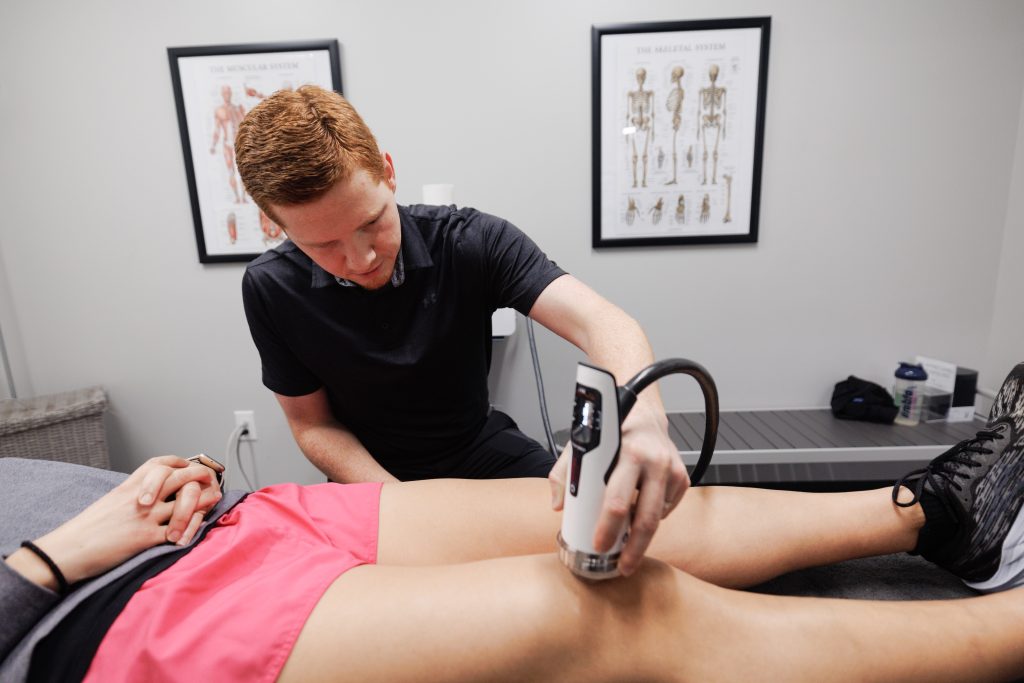Iliotibial Band Syndrome (ITBS), commonly referred to as IT Band pain, is a prevalent overuse injury, particularly among runners and cyclists. The iliotibial (IT) band is a thick band of fibrous tissue that runs along the outside of the thigh from the hip to the shin. It plays a crucial role in stabilizing the knee during activities like running and walking. However, when the IT band becomes tight or inflamed, it can lead to significant discomfort and pain. This blog post will delve into the common symptoms of IT Band pain, how it’s diagnosed, and the most effective treatment options, with a particular focus on the benefits of shockwave therapy.
Common Symptoms of IT Band Pain
IT Band pain typically presents as:
- Lateral Knee Pain: The most distinctive symptom is pain on the outer side of the knee, often described as sharp or burning. This pain is usually exacerbated by activities like running, cycling, or even walking up and down stairs.
- Tenderness and Swelling: The outside of the knee may become tender to the touch, and in some cases, mild swelling can occur.
- Pain During Flexion: Discomfort may increase when bending the knee, especially when the knee is at a 30-degree angle, which is often where the IT band rubs against the femur.
- Clicking Sensation: Some individuals may experience a clicking or snapping sensation as the IT band moves over the knee joint.
Diagnosis of IT Band Pain
Diagnosing IT Band pain involves a combination of clinical evaluation and imaging. Here’s what a typical diagnosis process might look like:
- Clinical History: A thorough review of the patient’s activity level, exercise routines, and the onset of symptoms helps in identifying patterns that suggest IT Band Syndrome.
- Physical Examination: A physical exam is crucial in diagnosing ITBS. Specific tests like the Ober’s test or the Noble compression test can help pinpoint IT Band tightness and pain.
- Imaging: While not always necessary, imaging techniques like MRI or ultrasound may be used to rule out other potential causes of knee pain and to assess the degree of inflammation in the IT band.
Treatment of IT Band Pain
Treating IT Band pain typically begins with conservative approaches such as rest, ice, and physical therapy. However, for patients who do not respond to these initial treatments, more advanced options like shockwave therapy may be recommended.

The Role of Shockwave Therapy in Treating IT Band Pain
What is Shockwave Therapy?
Shockwave therapy, also known as Extracorporeal Shockwave Therapy (ESWT), is a non-invasive treatment that uses high-energy sound waves to stimulate healing in damaged tissues. It is particularly effective for conditions involving tendons, ligaments, and other soft tissues, making it an ideal treatment for IT Band pain.
How Does Shockwave Therapy Work?
Shockwave therapy works by delivering focused sound waves to the affected area, which helps to:
- Stimulate Blood Flow: The sound waves promote increased blood circulation to the IT band, which enhances the body’s natural healing processes.
- Break Down Scar Tissue: Shockwave therapy helps break down adhesions and scar tissue that may be contributing to IT Band tightness and pain.
- Reduce Pain and Inflammation: The treatment has been shown to reduce both pain and inflammation, providing significant relief for patients suffering from chronic IT Band pain.
Benefits of Shockwave Therapy for IT Band Pain
- Non-Invasive: Unlike surgical interventions, shockwave therapy does not require incisions or anesthesia, making it a low-risk option for patients.
- Quick Recovery: Patients can often return to their regular activities sooner compared to more invasive treatments.
- Effective for Chronic Cases: For individuals who have not found relief through other treatments, shockwave therapy can be particularly beneficial.
What to Expect During Treatment
A typical shockwave therapy session for IT Band pain lasts about 15-20 minutes. Most patients require a series of treatments, usually 8-12 sessions. During the session, a gel is applied to the treatment area, and a handheld device is used to deliver the shockwaves. While the treatment can cause some discomfort, it is generally well-tolerated, and any pain typically subsides after the session.
Conclusion
IT Band pain can be a debilitating condition, especially for active individuals. However, with proper diagnosis and treatment, including innovative options like shockwave therapy, patients can achieve significant pain relief and return to their favorite activities. If you are struggling with IT Band pain, consult with a healthcare provider to discuss whether shockwave therapy might be right for you.

Recent Comments